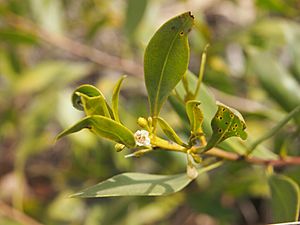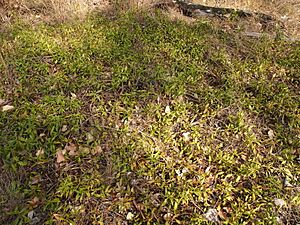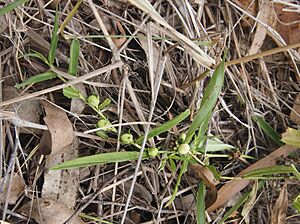Winter apple facts for kids
Quick facts for kids Winter apple |
|
|---|---|
 |
|
| Eremophila debilis flower and foliage | |
| Scientific classification | |
| Genus: |
Eremophila (plant)
|
| Species: |
debilis
|
| Synonyms | |
The winter apple (scientific name: Eremophila debilis) is a cool flowering plant. It's also called amulla sometimes. This plant belongs to the figwort family, which is known for its beautiful flowers. You can find the winter apple growing naturally only in Australia, from northern Queensland all the way down to the border of New South Wales and Victoria. It's a low-growing bush with long, spreading stems, shiny green leaves, and pretty white or light purple flowers.
Contents
What Does the Winter Apple Look Like?
The winter apple is a prostrate shrub, which means it's a bush that grows low to the ground. Its stems can spread out up to about 1 meter (or 3 feet) long.
Leaves and Stems
The leaves of the winter apple are a shiny green color. They are shaped like an oval or a spear, usually about 32 to 85 millimeters (1.3 to 3.3 inches) long and 8 to 20 millimeters (0.3 to 0.8 inches) wide. They are also glabrous, which means they are smooth and hairless. Most leaves have 3 or 4 pairs of noticeable teeth along their edges.
Flowers and Fruit
The flowers of the winter apple grow either by themselves or in small groups of up to three, right where the leaves meet the stem. Each flower sits on a short stalk, about 3.5 to 7.5 millimeters (0.1 to 0.3 inches) long.
Before the petals open, there are 5 green, spear-shaped sepals (leaf-like parts that protect the bud), which are about 7 to 10 millimeters (0.3 to 0.4 inches) long. The petals themselves are about 8.5 to 11 millimeters (0.3 to 0.4 inches) long. They are joined together at the bottom to form a tube. This petal tube is usually white, but sometimes it can be a pale purple color. Unlike many other plants in its group, the winter apple's flowers don't have spots! The outside of the flower tube is smooth, but the inside is covered with soft hairs. Inside the tube, there are four stamens (the parts that produce pollen), which are completely hidden.
The winter apple usually flowers in spring and summer. After the flowers, it grows round, fleshy fruits. These fruits are white to reddish-purple and are about 7 to 10 millimeters (0.3 to 0.4 inches) across.
How Was the Winter Apple Named?
The winter apple was first officially described in 1802 by a person named Henry Cranke Andrews. He first gave it a different name, Pogonia debilis. Later, in 1810, Robert Brown changed its name to Myoporum debile. Finally, in 1992, Robert Chinnock gave it the name we use today, Eremophila debilis.
The second part of its scientific name, debilis, comes from a Latin word that means "weak" or "feeble." This refers to the plant's branches, which are thin and spread out along the ground.
Where Does the Winter Apple Grow?
The winter apple is very common in eastern Queensland and New South Wales in Australia. It can grow in many different types of soil and in various plant communities. You often find it growing among box trees and white cypress trees, sometimes forming thick mats on the ground. It has also been seen near Boosey in Victoria. Interestingly, it's also found in New Zealand, but scientists think it got there naturally, perhaps by seeds carried by birds or water.
Using the Winter Apple in Gardens
Even though its scientific name is Eremophila debilis, many gardeners know the winter apple by its older name, Myoporum debile. It's a great plant to use as a groundcover in many gardens, as long as the soil drains water well. Its flowers, fruit, and shiny leaves make it a very attractive plant.
This plant can handle frost, which means it can survive cold temperatures. If the conditions are just right, it can even layer, which is when a stem touches the ground and grows new roots, forming a new plant. Growing new plants from its seeds can be tricky, but it's quite easy to grow new winter apple plants from cuttings taken from the current year's growth.
Images for kids






